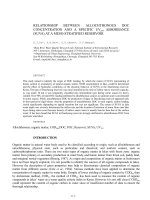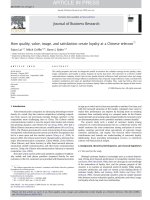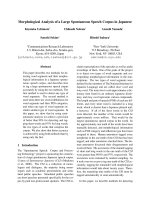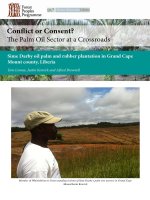Season-dependent fine root production at a deciduous Quercus serrata plantation in Japan
Bạn đang xem bản rút gọn của tài liệu. Xem và tải ngay bản đầy đủ của tài liệu tại đây (859.21 KB, 5 trang )
Life Sciences | Agriculture
Doi: 10.31276/VJSTE.61(4).48-52
Season-dependent fine root production at a
deciduous Quercus serrata plantation in Japan
Tran Van Do1, 2*
Silviculture Research Institute, Vietnamese Academy of Forest Sciences, Hanoi, Vietnam
JSPS postdoctoral fellow (2012-2014) at Forestry and Forest Products Research Institute, Tsukuba, Japan
1
2
Received 23 July 2019; accepted 23 October 2019
Abstract:
Introduction
The production of fine roots (diameter ≤2 mm)
contributes considerably to carbon cycling in forest
ecosystems. Fine roots constitute a significant organic
matter pool with high net primary productivity and
turnover. In this study, fine root decomposition,
mortality, and production were estimated at a Quercus
serrata Murr. plantation in Japan by using rates of
diameter-dependent root mortality, decomposition, and
the thickening method employed. Sequential soil core
and litter bag techniques were used to collect field data.
The experiments were set up in a 20×20 m plot. The
data were collected five times (May, August, November,
and December 2013, as well as April 2014) during a
one-year period, and fine roots were classified into ones
with a diameter of ≤1 mm and others of 1-2 mm. The
results indicate that fine root decomposition, mortality,
and production in a Q. serrata plantation are seasondependent and are higher in the summer compared to
the winter. In the summer, production reached 1.365
g m-2 day-1, while it was lower than 0.132 g m-2 day-1
in the winter. The total fine root production of the Q.
serrata plantation was 1.364 tonnes ha-1 year-1. The
mortality was 0.440 tonne ha-1 year-1, and the amount
decomposed to return nutrients to the soil was 0.108
tonne ha-1 year-1.
Roots with a diameter of ≤2 mm are called fine roots.
Their production plays an important role in forest carbon
cycling [1]. Fine roots have high net primary production
(NPP) and turnover because of their short longevity - up
to several months [1-2]. It has been estimated that fine root
production may contribute 75% of the total NPP in a forest
[2]. Several factors, including vegetation type, soil fertility,
temperature, and precipitation, affect the production of
fine roots [1, 3]. Using a global database, Finer, et al. [1]
indicated that fine root production and turnover increase
from boreal to tropical forests. Fine root production and
turnover are estimated by different methods, which may
cause different estimations even in the same site [4].
Keywords: climate, continuous inflow method,
decomposition, fine root differentiation, time interval.
Classification number: 3.1
A number of methods exist for estimating fine root
production [5-7], and there is no standard method available.
Comparative studies indicate significant differences in
fine root estimation between methods [8]. The true answer
regarding the best method is unknown because each method
has potential biases, leading to over- or underestimation
[3, 8]. Recently, Tran, et al. [9] developed a new method
for estimating fine root production based on the continuous
inflow method [7], which assumes that fine roots grow, die,
and decompose simultaneously. This method [9] provides
more accurate fine root production estimation, as it considers
the difference in the amount and decomposition ratios of
thinner and coarser fine roots (those of ≤1 mm in diameter
and those 1-2 mm in diameter).
The objective of this study is to estimate fine root
production at a deciduous Quercus serrata Murr. (Q.
serrata) plantation by using rates of diameter-dependent
root mortality, decomposition, and the thickening method
employed.
Materials and methods
Study site
This study was conducted in a pure plantation of the
deciduous Q. serrata at 36000′30′′N, 104007′54′′E in
*Email:
48
Vietnam Journal of Science,
Technology and Engineering
DECEMBER 2019 • Vol.61 Number 4
Life Sciences | Agriculture
Tsukuba, Japan. Trees were planted with a spacing of
approximately 5×4 m. At the time of the experiment, the
plantation had a stem height of 12-30 m and a diameter
at breast height of 15-35 cm. A one-year field observation
revealed that Q. serrata trees produce leaves in early April
and shed in mid-October. During the December-April
period, no leaves are available on trees. The site has an
average annual precipitation of 1,283 mm and an average
monthly temperature of 13.20C. The maximum temperature
was recorded in August (350C), while minimum temperature
was recorded in January (0.40C).
Experiment
Data were collected at a 20×20 m plot. Sequential soil
cores and litter bag techniques were used to collect data. A
tube of 32 mm in diameter and 45 cm in length was used
to take soil samples vertically to a depth of 21 cm in May,
August, November, and December 2013, as well as April
2014. During each sampling period, 24 soil cores were
collected randomly from a 20×20 m plot. The soil collected
was washed and sieved through water to separate fine roots.
A steel sieve with a mesh size of 0.2 mm was used. Water was
poured directly on the soil in the sieve with high pressure to
break and wash away soil particles, and then fine roots were
recovered manually. The dead and living fine roots were
classified by their colour, resilience, and structural integrity.
Generally, dead fine roots have a dark/black colour, while
living fine roots are bright and yellow-brown in colour. Fine
roots were then further classified into two classes as those
with a diameter of ≤ 1 mm and those with a diameter of 1-2
mm. Those categorised as fine roots were dried at 800C until
a constant mass and then weighed (accuracy of 0.0001 g)
for a mass of live roots (biomass/B), as well as that of dead
roots (necromass/N) for both size classes, separately.
Litter bags (size of 10×15 cm) were made of special
cloth, which was produced by Toyobo Co., Osaka, Japan.
The cloth had a pore size of 6 µm, which can block the
ingrowth of fine roots. Dead fine roots used in the litter bag
technique were collected from the field and then oven-dried
for a constant mass as mentioned above. Each bag contained
a fine root mass of 0.7-1.3 g, which was inserted inside the
bag with some fine soil collected from the same site. Before
burying them in the field, litter bags were soaked in ordinary
water for 24 hours to ensure that the moisture content of
the fine roots in the litter bags was similar to that in nature.
In total, 60 bags were made and systematically buried in
May 2013 at a 20×20 m plot with a distance of 2 m x 2
m between each other. At the same time as the soil core
collection (August, November, and December 2013, as well
as April 2014), 15 litter bags were collected. The collected
bags were washed and sieved with water for the remaining
fine roots, which were then oven-dried for a constant mass.
The remaining mass was weighed (accuracy of 0.0001 g)
and used to estimate the decomposition ratio (γ) by the
following equation: {γ = (initial mass - remained mass)/
initial mass}.
Data analysis
The continuous inflow method [7] was applied to
estimate fine root production (P)
33 (Eq. 1), mortality (M) (Eq.
2), and decomposition (D) (Eq. 3).
(1)
𝑃𝑃 = (𝐵𝐵𝑗𝑗 − 𝐵𝐵𝑖𝑖 ) + (𝑁𝑁𝑗𝑗 − 𝑁𝑁𝑖𝑖 ) + *−(𝑁𝑁𝑗𝑗 − 𝑁𝑁𝑖𝑖 ) − ((𝑁𝑁𝑗𝑗 − 𝑁𝑁𝑖𝑖 )/𝛾𝛾𝑖𝑖𝑖𝑖 + 𝑁𝑁𝑖𝑖 ) ∗ 𝑙𝑙𝑙𝑙(1 − 𝛾𝛾𝑖𝑖𝑖𝑖 )+ (1)
(1)
(2)
𝑀𝑀 = (𝑁𝑁𝑗𝑗 − 𝑁𝑁𝑖𝑖 ) + 𝐷𝐷
(3)
(3)
(3)
𝐷𝐷 = −(𝑁𝑁𝑗𝑗𝑗𝑗 − 𝑁𝑁𝑖𝑖𝑖𝑖 ) − ((𝑁𝑁𝑗𝑗𝑗𝑗 − 𝑁𝑁𝑖𝑖𝑖𝑖 )/𝛾𝛾𝑖𝑖𝑖𝑖𝑖𝑖𝑖𝑖 + 𝑁𝑁𝑖𝑖𝑖𝑖 ) ∗ 𝑙𝑙𝑙𝑙(1 − 𝛾𝛾𝑖𝑖𝑖𝑖𝑖𝑖𝑖𝑖 )
where Bi and Bj represent the masses of living fine roots
(biomass)
times the
ti and
(tj > ti),
Ni and
where BBii and
and at
Bjj represent
massestj,ofrespectively
living fine roots (biomass)
at times
tii andNtjjj,
where
denote
the
dead
(necromass),
is
respectively
(tjj >masses
tii), Nii and Nof
the fine
massesroots
of dead fine
roots (necromass),and
and γγijij isij the
jj denote
the
decomposition
ratio.
decomposition
ratio.
The
was
for
size
aa diameter
of
The
estimation
was
conducted
for (those
two with
size
classes
The estimation
estimation
was conducted
conducted
for two
two
size classes
classes separately
separately
(those
with
diameter
of ≤1
≤1
mm
and
those
with
a
diameter
of
1-2
mm).
Then,
the
total
decomposition,
mortality,
and
separately
withofa1-2diameter
and those
with
mm and those (those
with a diameter
mm). Then,of
the ≤1
total mm
decomposition,
mortality,
and
of
fine
roots
with
aa diameter
of
mm)
calculated
production
of all
all of
fine 1-2
roots (those
(those
with Then,
diameterthe
of ≤2
≤2total
mm) were
were
calculated from
from two
two
aproduction
diameter
mm).
decomposition,
classes.
classes.
mortality,
and production of all fine roots (those with a
diameter
ofinin≤2
were(the
from
classes.(the
Differences
finemm)
root biomass
biomass
(thecalculated
mass of
of living
living fine
fine
roots)two
and necromass
necromass
(the mass
mass
Differences
fine
root
mass
roots)
and
of dead
fine
roots)
amongst
the
five
collection
periods
(May,
August,
November,
and
Differences in fine root biomass (the mass of living fine
December
2013,
as
well
as
April
2014)
–
as
well
as
in
fine
root
decomposition
ratio,
roots) and necromass (the mass of dead fine roots) amongst
production, mortality, and decomposition amongst four collection intervals (May-August,
the five collection periods (May, August, November, and
August-November, November-December, and December-April) – were assessed by
December 2013, as well as April 2014) - as well as in
univariate analysis of variance (ANOVA) and post-hoc tests. All analyses were conducted
fine
root9.2decomposition
using SAS
SAS
(SAS Institute
Institute Inc.,
Inc., Cary,
Cary,ratio,
NC, USA).
USA).production, mortality, and
using
9.2 (SAS
NC,
decomposition amongst four collection intervals (MayResults
August,
August-November, November-December, and
December-April)
were assessed
by univariate
analysisinin of
The
fine
root
and
ratio
the
The fine root biomass,
biomass,-necromass,
necromass,
and decomposition
decomposition
ratio differed
differed significantly
significantly
the
variance
and post-hoc
five collection(ANOVA)
periods and collection
intervals (Tabletests.
1). In 1-2All
mm analyses
fine roots, thewere
highest
-2
conducted
using
SAS2013
9.2
Institute
NC,in
biomass was found
in December
(94.2(SAS
g m-2), while
the lowestInc.,
biomassCary,
was observed
-2
May 2013 (33.9 g m-2). The highest necromass in 1-2 mm fine roots was appeared in
USA).
-2
-2
November 2013 (32.3 g m-2), and the lowest was found in May 2013 (14.8 g m-2). In terms of
Results
the decomposition ratio, the highest figure was found during the May-August period (0.00085
-1
-1
day-1The
), and fine
the lowest
recorded duringnecromass,
the December-April
(0.00010 day-1). A
rootwasbiomass,
andperiod
decomposition
similar differed
pattern was found
in ≤ 1 mm fine roots. The highest biomass was found in December
ratio
-2 significantly in the five collection periods
-2
2013 (106.3 g m-2), while the lowest biomass was discovered in May 2013 (63.0 g m-2). The
and collection intervals (Table 1). In 1-2
mm
fine
roots,
the
-2
highest necromass was found in November 2013 (44.7 g m-2), and the lowest was recorded-2 in
-2
highest biomass-2was found in December 2013 (94.2 g m ),
August 2013 (27.4 g m ). In terms of the decomposition ratio, the highest figure was found
while
theMay-August
lowest period
biomass
inwas
May
2013during
(33.9
during-2 the
the
(0.00145was
day-1observed
and the
the lowest
lowest
discovered
the
during
May-August period
(0.00145
day
),), and
was discovered
during the
-1
gDecember-April
m ). Theperiod
highest
necromass
in
1-2
mm
fine
roots
was
(0.00010 day
day ).).
December-April period (0.00010
appeared in November 2013 (32.3 g m-2), and the lowest
Table 1.found
The fine in
root May
biomass,2013
necromass,
and decomposition
ijij) (± standard
was
(14.8
g m-2). ratio
In (γterms
of the
error)
of
two
size
classes.
decomposition ratio, the highest figure was found during
dates
mm fine-1roots
theCollection
May-August
period (0.00085≤1day
), and the lowest was
Collection
dates 1-2 mm fine roots
Biomass Necromass γijijij
Biomass
Necromass
γijijij
-1
recorded during
the
period
-2
-2 December-April
-1
-2
-2
-2
-1
-2
(g mm-2))
(g mm-2))
(day-1))
(g mm-2))
(g mm-2-2-2)) (0.00010
(day-1-1-1)) day ).
(g
(g
(day
(g
(g
(day
a
a
afine roots. The
AMay,similar
pattern
was
found in63.0±6.1
≤ aaa1 mm
2013
33.9±4.5aa 14.8±1.6aa
27.5±2.2aa
highest
biomass
was
found
in
December
2013
(106.3
g m-2),
August, 2013
38.0±4.1aaa 16.1±1.5aaa
0.00085±.00009aaa 64.7±6.2aaa
27.4±2.5aaa
0.00145±.00015aaa
August, 2013
38.0±4.1
16.1±1.5
0.00085±.00009
64.7±6.2
27.4±2.5
0.00145±.00015
b
60.6±5.8bb
November, 2013 60.6±5.8
b
32.3±2.9bb
32.3±2.9
b
0.00038±.00004bb
0.00038±.00004
b
83.6±7.6bb
83.6±7.6
b
44.7±4.5bb
44.7±4.5
b
0.00052±.00009bb
c
94.2±9.2cc
b
30.6±2.6bb
c
0.00019±.00001cc
c
106.3±10.1cc
c
34.6±3.2cc
c
0.00021±.00001cc
ddd
aaa
ddd
ddd
ddd
December, 2013
Vietnam Journal of Science,
DECEMBER 2019
4
49
April, 2014 • Vol.61
52.4±4.9 Number
18.2±1.7
0.00010±.00001
54.5±4.9 and19.0±1.8
0.00010±.00001
Technology
Engineering
eee
Different letters (a,a, b,b, c,c, d,d, ee) in a column indicate significant differences of means at p = 0.05.
Different letters (
) in a column indicate significant differences of means at p = 0.05.
The fine root decomposition, mortality, and production in both size classes of ≤1 mm (Fig.
Life Sciences | Agriculture
Table 1. The fine root biomass, necromass, and decomposition ratio (γij) (± standard error) of two size classes.
Collection dates
1-2 mm fine roots
≤1 mm fine roots
Biomass (g m )
Necromass (g m )
Biomass (g m-2)
Necromass (g m-2)
May, 2013
33.9±4.5a
14.8±1.6a
63.0±6.1a
27.5±2.2a
August, 2013
38.0±4.1a
16.1±1.5a
0.00085±.00009a
64.7±6.2a
27.4±2.5a
0.00145±.00015a
November, 2013
60.6±5.8b
32.3±2.9b
0.00038±.00004b
83.6±7.6b
44.7±4.5b
0.00052±.00009b
December, 2013
94.2±9.2c
30.6±2.6b
0.00019±.00001c
106.3±10.1c
34.6±3.2c
0.00021±.00001c
April, 2014
52.4±4.9d
18.2±1.7a
0.00010±.00001d
54.5±4.9e
19.0±1.8d
0.00010±.00001d
-2
-2
γij (day )
-1
γij (day-1)
Different letters (a, b, c, d, e) in a column indicate significant differences of means at p = 0.05.
Fig. 1. Decomposition, mortality, and production (g m-2 d-1) of ≤1 mm fine roots. Bars indicate + standard error.
Fig. 2. Decomposition, mortality, and production (g m-2 d-1) of 1-2 mm fine roots. Bars indicate + standard error.
while the lowest biomass was discovered in May 2013 (63.0
g m-2). The highest necromass was found in November 2013
(44.7 g m-2), and the lowest was recorded in August 2013
(27.4 g m-2). In terms of the decomposition ratio, the highest
figure was found during the May-August period (0.00145
day-1), and the lowest was discovered during the DecemberApril period (0.00010 day-1).
The fine root decomposition, mortality, and production
in both size classes of ≤1 mm (Fig. 1) and 1-2 mm (Fig. 2)
were season-dependent, and the trends were similar in both
classes. The highest decomposition was found during the
May-August period (0.058 g m-2 day-1 for the ≤1 mm class
and 0.0072 g m-2 day-1 for the 1-2 mm class; Figs. 1 and
2), while the lowest decomposition was recorded during the
December-April period. The highest mortality was found
during the August-November period (0.311 g m-2 day-1 for
the ≤1 mm class and 0.186 g m-2 day-1 for the 1-2 mm class),
50
Vietnam Journal of Science,
Technology and Engineering
and the lowest mortality was observed during the DecemberApril period for both classes. The highest production levels
occurred during the November-December period (0.769 g
m-2 day-1 for the ≤1 mm class and 0.595 g m-2 day-1 for the
1-2 mm class). The lowest production was recorded during
the December-April period for both classes.
The total fine root decomposition, mortality, and
production of both classes (Fig. 3) had the same trends in
each class (Figs. 1 and 2), with the highest decomposition
during the May-August period (0.066 g m-2 day-1) and
the lowest during the December-April period; the highest
mortality during the August-November period (0.493 g m-2
day-1) and the lowest during the December-April period; the
highest production during the November-December period
(1.36 g m-2 day-1) and the lowest during the December-April
period (Fig. 3).
DECEMBER 2019 • Vol.61 Number 4
Life Sciences | Agriculture
Fig. 3. Decomposition, mortality, and production (g m-2 d-1) of all fine roots (≤2 mm). Bars indicate + standard error.
In this study, the Q. serrata plantation had a fine root
decomposition of 0.108 tonnes ha-1 year-1, a mortality of
0.440 tonnes ha-1 year-1, and a production of 1.364 tonnes
ha-1 year-1 (Fig. 4).
Fig. 4. Total decomposition, mortality, and production of fine
roots in a 1-year duration.
Discussion
The fine root production of Q. serrata is season-dependent
(Figs. 1 and 2). The Q. serrata plant produces leaves in the
early summer (April) and sheds in the early winter (midOctober). The quick growth of fine roots during the AprilMay period and the peak during October correspond to
leafing and shedding, respectively [10]. Leafing requires
energy and nutrients to support the growth of numerous
new leaves; therefore, fine roots must grow quickly to meet
such requirements, sustaining tree life. During the winter
when there are no leaves, trees still require energy while
there is no photosynthesis, so they must store energy during
photosynthesis. Thus, the high level of fine root production
before shedding leaves could be explained by saving energy
for the winter.
The decomposition of litter in general and fine roots,
in particular, is controlled by several factors, such as
environmental conditions (temperature, humidity) and
quality of the litter itself (nutrient content) [11-12]. The low
decomposition in the present study (Fig. 4) was probably
controlled by temperature. Since there is a prolonged
winter of 6 months, the temperature dropped to -20C with
snowfall during the field experiment, leading to inhibited
microorganism activity for the decomposition of dead fine
roots. In addition, Q. serrata sheds all leaves in winter,
leading to large amounts of organic matter on the forest
floor. Therefore, the decomposing fine roots were limited
because of the overload of organic matter [13].
The amount of dead fine roots was also low in the
present study (Fig. 4; less than 30% production), which
indicates less organic matter returning to the soil from fine
roots, leading to low soil nutrient content. This phenomenon
is probably a physiological reaction of Q. serrata to the low
temperatures in winter [9-10]. If more fine roots die, then
new fine roots must grow in the following year to support
the tree’s growth. This process requires a great deal of
energy, but trees cannot absorb nutrients from the soil or
conduct photosynthesis because leaves are not available in
the winter. Therefore, the fine root decomposition, mortality,
and production of deciduous forests differ from those of
evergreen broadleaved forests [14, 15].
Several factors affect fine root production, including
forest type and age, climate, and soils. The fine root
production in this study was 1.36 tonnes ha-1 year-1. It was
5.78 tonnes ha-1 year-1 in a secondary Q. serrata forest in
Ohtsu, Japan [9]. According to another study, fine root
production was 3.65 tonnes ha-1 year-1 [15] and 1.13 tonnes
ha-1 year-1 in old-growth and secondary [14] evergreen
tropical forests, respectively, in Vietnam. Those figures
demonstrate the significant difference of fine root production
amongst sites. Therefore, estimating fine root production
locally is becoming important for a deep understanding of
fine root functioning in the forest carbon cycle and nutrient
return.
Conclusions
The fine root decomposition, mortality, and production
at a Q. serrata plantation were estimated based on the
continuous inflow method to separate fine roots into two
classes: ≤1 mm in diameter and 1-2 mm in diameter.
DECEMBER 2019 • Vol.61 Number 4
Vietnam Journal of Science,
Technology and Engineering
51
Life Sciences | Agriculture
Mortality and production were season-dependent, and they
were higher in the summer as compared to the winter.
The total production of the study forest was 1.364 tonnes
ha-1 year-1, of which mortality accounted for 0.440 tonnes
ha-1 year-1. In a duration of one year, 0.108 tonnes ha-1 year-1
of dead fine roots decomposed to return nutrients to the soil.
ACKNOWLEDGEMENTS
This research is funded by Japan Society for the
Promotion of Science. Comments from anonymous
reviewers on the manuscript are highly appreciated.
The author declares that there is no conflict of interest
regarding the publication of this article.
References
[1] L. Finer, M. Ohashi, K. Noguchi, Y. Hirano (2011), “Fine
root production and turnover in forest ecosystems in relation to stand
and environmental characteristics”, For. Ecol. Manage., 262(11),
pp.2008-2023.
[2] R.A. Gill, R.B. Jackson (2000), “Global patterns of root
turnover for terrestrial ecosystems”, New Phytol., 147, pp.13-31.
[3] Z.Y. Yuan, H.Y.H. Chen (2012), “Indirect methods produce
higher estimates of fine foot production and turnover rates than direct
methods”, PLOS ONE, 7(11), e48989.
[4] I. Brunner, M.R. Bakker, R.G. Bjork, Y. Hirano, et al. (2013),
“Fine-root turnover rates of European forests revisited: an analysis
of data from sequential coring and ingrowth cores”, Plant and Soil,
362(1-2), pp.357-372.
[5] H. Majdi, K. Pregitzer, A.S. Moren, J.E. Nylund, G.I. Agren
(2005), “Measuring fine root turnover in forest ecosystems”, Plant
and Soil, 276(1-2), pp.1-8.
[6] D.F. Metcalfe, P. Meir, M. Williams (2007), “A comparison
of methods for converting rhizotron root length measurements into
estimates of root mass production per unit ground area”, Plant and
Soil, 301(1-2), pp.279-288.
52
Vietnam Journal of Science,
Technology and Engineering
[7] A. Osawa, R. Aizawa (2012), “A new approach to estimate
production, mortality and decomposition of fine roots using litterbag experiments and ordinary soil-core techniques”, Plant and Soil,
355(1-2), pp.167-181.
[8] D.J. Milchunas (2009), “Estimating root production:
comparison of 11 methods in shortgrass steppe and review of biases”,
Ecosystems, 12(8), pp.1381-1402.
[9] V.D. Tran, A. Osawa, T. Sato (2016a), “Estimation of fineroot production using rates of diameter-dependent root mortality,
decomposition and thickening in forests”, Tree Physiology, 36(4),
pp.513-523.
[10] V.D. Tran, T. Sato, O. Kozan (2016b), “A new approach for
estimating fine root production in forests: a combination of ingrowth
core and scanner”, Trees, 30(2), pp.545-554.
[11] T. Bueis, M.B. Turrion, F. Bravo, V. Pando, A. Muscolo
(2018), “Factors determining enzyme activities in soils under Pinus
halepensis and Pinus sylvestris plantations in Spain: a basis for
establishing sustainable forest management strategies”, Ann. For. Sci.,
75(1), Doi: 10.1007/s13595-018-0720-z.
[12] M.P. Krishna, M. Mohan (2017), “Litter decomposition in
forest ecosystems: a review”, Energy, Ecol. Environ., 2(4), pp.236249.
[13] D.C. Coleman, D.A.Jr. Crossley, P.F. Hendrix (2004),
“Secondary production: activities of heterotrophic organisms-the soil
fauna”, Fundamentals of Soil Ecology, Elsevier Inc., pp.77-171.
[14] V.D. Tran, T. Sato (2018), “Towards carbon certificate
in Vietnam: net ecosystem production and basic income for local
community”, Environmental resources use and challenges in
contemporary Southeast Asia: tropical ecosystems in transition,
Springer, pp.79-96.
[15] V.D. Tran (2017), “Estimating net ecosystem production of
tropical forest”. Sustainable Humanosphere, 13, pp.5-6.
DECEMBER 2019 • Vol.61 Number 4









